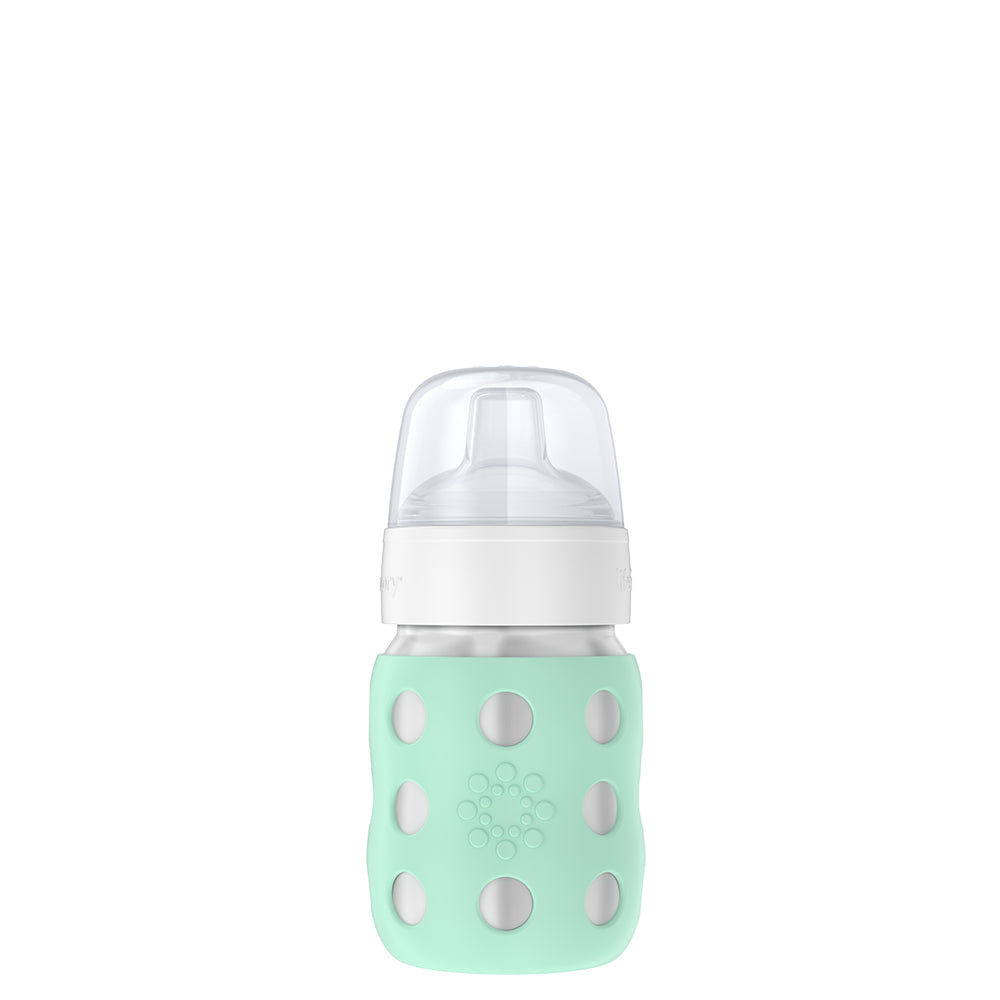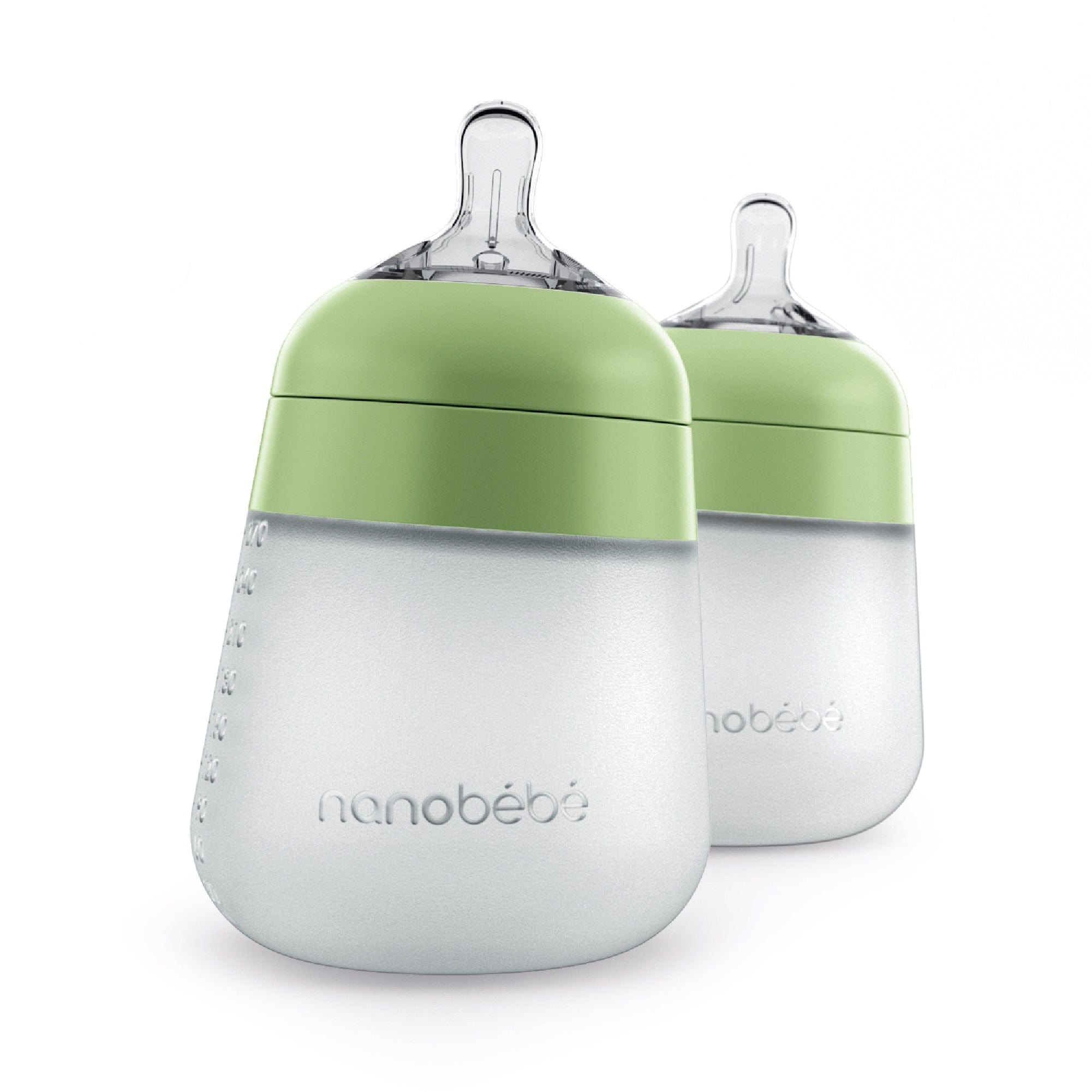Best and Safest Non-toxic and Eco-friendly Baby Bottles: Lead-Free Glass and Stainless Steel Top Picks
Share
Last Updated: November 16, 2025
2025 Baby Bottle Safety in 60 Seconds
- Avoid All Plastic: Groundbreaking research confirms all plastic bottles, including BPA-free ones, release millions of microplastic particles when heated for formula preparation.
- Beware of Painted Glass: 91% of painted glass bottles contain lead on their exterior markings, which can transfer to hands. Always choose clear, unpainted glass.
- Safest Materials: The science is clear—the safest, most inert materials for baby bottles are verified lead-free glass and food-grade stainless steel.
- Top Pick for Value & Safety: Evenflo's Classic Glass bottles are independently tested as lead-free and offer unparalleled safety at a budget-friendly price.
Choosing a baby bottle has become a critical health decision. As a mom who made the shift to a non-toxic and sustainable lifestyle, I spent hundreds of hours trying to navigate this research for my own family when shocking new data on microplastics and hidden lead emerged.
My goal with this guide is to save you that time. At Nature Kids Co., we rigorously research and evaluate every product against our core values. This guide cuts through the marketing claims to give you science-backed recommendations based on the latest 2024 and 2025 data, so you can feed your baby with peace of mind.
2025 Important Safety Alerts: What Every Parent Must Know
How Did We Get Here? A Timeline of Discoveries
Recent years have uncovered serious, previously unknown risks in products once considered safe.
- October 2020: The Microplastic Bombshell. Research in Nature Food reveals polypropylene baby bottles release millions of microplastics when heated, leading to 2024 class-action lawsuits against major brands like Philips Avent and Dr. Brown's.
- March 2024: The Hidden Lead Danger. Consumer safety advocates using XRF testing find that 91% of painted glass baby bottles have lead in their exterior markings. The lead is confirmed to transfer to hands during normal use.
- July 2024: The "Safe" BPA Alternatives Aren't Safe. A study in the Journal of Xenobiotics demonstrates that BPS and BPF—chemicals used in "BPA-Free" plastics—accumulate in cells just like BPA and pose similar endocrine-disrupting risks.
The Science Behind the 2025 Warnings
The promise of "BPA-Free" plastic was a marketing tactic, not a safety guarantee. The fundamental problem is the plastic itself.
How Do Microplastics from Bottles Affect Infant Health?
When you heat a plastic bottle to the standard 70°C (158°F) to prepare formula, the plastic matrix degrades and releases microscopic particles. The groundbreaking Nature Food study found that infants may consume over 1.5 million microplastic particles daily this way. While the full health impact is still under investigation, these particles are known to accumulate in developing organs and can carry other harmful chemicals, with potential impacts on the digestive, reproductive, and immune systems.
The False Promise of "BPA-Free"
In a way, yes. Manufacturers replaced BPA with structurally similar chemicals like BPS and BPF. A systematic review in Environmental Health Perspectives confirmed these alternatives have "hormonal potency in the same order of magnitude and similar action compared to BPA." They are not safer, just different. They interfere with endocrine function and may contribute to hormonal disruption, just like the chemical they replaced.
The Hierarchy of Safe Materials
Based on current science, there's a clear hierarchy for baby bottle safety. Plastic is no longer a recommended option.
- Verified Lead-Free Glass: The gold standard. Glass is inert, meaning it releases nothing into milk at any temperature. The only risk is exterior lead paint, making unpainted, clear glass the safest choice.
- Food-Grade Stainless Steel: Extremely durable, non-leaching, and unbreakable. An excellent and practical choice for safety and longevity.
- Medical-Grade Silicone: The best flexible alternative. It's far safer than plastic and doesn't break down into microplastics. Ensure it's 100% medical-grade, as lower-quality silicone can contain fillers.
Disclosure: This post contains Amazon affiliate links. As an Amazon Associate, we may earn from qualifying purchases. This helps support our independent research.
Our Vetting Process
Each bottle in this guide is rigorously researched and evaluated according to our core principles:
- Material Safety: Is it *truly* inert? We prioritize unpainted glass, stainless steel, and medical-grade silicone.
- Scientific Validation: We review independent tests (like XRF for lead) and new research (like microplastic studies).
- Brand Transparency: Does the brand disclose its materials and testing? We penalize brands with a history of poor transparency (like Pura).
- Real-World Function: Does it leak? Is it easy to clean? Does it help with colic?
Best Lead-Free Glass Bottles
Glass is the purest material available. Our top picks are all unpainted and have been independently verified to be lead-free in their material and any minimal markings.

Evenflo Classic Glass Bottles
Our #1 recommendation. These simple, affordable bottles are made from clear, unpainted, tempered glass. They are XRF-tested as completely lead-free and the twisted design provides a secure grip. A perfect combination of ultimate safety and value.

Haakaa Generation 3 Glass Bottle
Made from temperature-resistant borosilicate glass, this bottle is XRF-tested with no detectable lead, arsenic, or mercury. Its orthodontic thumb-shaped nipple is designed to mimic breastfeeding, making it a top choice for combination-feeding families.

Emulait Glass Anatomy Bottle
A new kid on the block, Emulait features a patented nipple designed to replicate the anatomy and function of a real breast, making it an exceptional choice for babies who refuse other bottles. We personally reviewed the XRF test results to ensure its borosilicate glass bottle is non-detect for lead and meets all safety standards.

Lifefactory Glass Baby Bottles
These bottles combine a thermal shock-resistant borosilicate glass bottle with a protective medical-grade silicone sleeve. This provides an easy grip and extra protection against breakage. The set grows with your child, converting to a sippy cup.
Best Stainless Steel Bottles
Stainless steel offers the best of both worlds: it's as safe and inert as glass, but it's completely unbreakable and lightweight.

Lifefactory Stainless Steel Baby Bottle
A vacuum-insulated bottle made from food-grade 304 stainless steel. It's designed to keep liquids at the desired temperature and features a wide neck for easy cleaning and a non-slip silicone sleeve. A safe, eco-friendly choice that lasts for generations.
Best Silicone Bottles
For parents who want a lightweight, non-breakable option that's softer than steel, medical-grade silicone is the safest choice after glass and stainless.

Comotomo Silicone Baby Bottles
Made from 100% medical-grade silicone, these bottles are soft, squeezable, and designed to closely mimic breastfeeding, reducing nipple confusion. They are XRF-tested as lead-free and consistently rated as a top choice for transitioning babies.

Nanobebe Flexy Silicone Bottles
This award-winning bottle is made from a single piece of medical-grade silicone, making it easy to clean and safe. Its stable, non-tipping base and soft texture make it easy for little hands to hold, promoting self-feeding skills.
Brands to Approach with Caution
Based on our research, we recommend caution with the following brands due to ongoing legal challenges or historical safety issues.
Brands Under Legal Challenge for Microplastics
The following brands are subject to 2024 class-action lawsuits alleging a failure to warn consumers about microplastic release from their **plastic bottle lines**. Their glass versions are generally considered safe choices.
- Philips Avent (plastic bottles)
- Dr. Brown's (plastic bottles)
- NUK (plastic bottles)
- Tommee Tippee (plastic bottles)
Historical Safety Concerns
Pura Kiki: While marketing "non-toxic certified" bottles, the company's insulated stainless steel bottles made before 2017 used a lead-based solder dot. Though covered, the company's failure to issue a formal recall and lack of transparency are concerning. We cannot recommend this brand.
Frequently Asked Questions
Are glass baby bottles safe from breakage?
While any glass can break, modern baby bottles are made from tempered or borosilicate glass, which is much more durable and resistant to thermal shock. Options with silicone sleeves, like Lifefactory, offer excellent additional protection.
Why is unpainted glass so important?
Independent testing found that 91% of glass baby bottles with painted logos or measurement markings contained lead, a potent neurotoxin. The lead can transfer from the bottle to hands during handling. Choosing clear, unpainted glass eliminates this risk entirely.
Is "BPA-Free" a meaningless label now?
Essentially, yes. It only means the bottle doesn't contain one specific chemical (Bisphenol-A). Manufacturers replaced it with similar chemicals (BPS, BPF) that are now known to have similar endocrine-disrupting effects. The core issue is the unstable plastic matrix, not just one chemical.
What is the most cost-effective non-toxic bottle?
Evenflo Classic Glass bottles offer the best combination of ultimate safety and low price, often costing less than $3 per bottle. Over the long term, stainless steel bottles can also be very cost-effective as they are unbreakable and can be used for years, transitioning with your child to a sippy or water bottle.
How should I clean glass or stainless steel bottles?
Both glass and stainless steel bottles are dishwasher safe (top rack recommended). They can also be hand-washed with a bottle brush and mild soap, or sterilized in boiling water. Because they are non-porous, they won't absorb odors or colors like plastic or silicone can.
Are silicone bottles as sustainable as glass or steel?
While significantly better than plastic, silicone is not as sustainable as glass or stainless steel. Glass and steel are infinitely recyclable without loss of quality. Silicone is highly durable but can typically only be recycled at specialized facilities, which are not widely available.
This guide is the result of years of ongoing research into child product safety, compiled by a mom dedicated to helping other parents navigate these important decisions.
